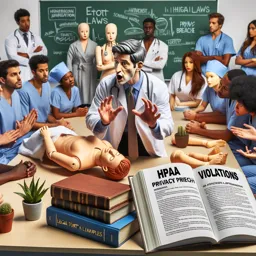Course content
Introduction to CME - Sterilized Material Center
2History and evolution of CME
3Functions and responsibilities of CME in nursing
4CME Rules and Regulations
5Principles of sterilization
6Types of sterilization
7Dry heat sterilization
8Moist heat sterilization
9Radiation sterilization
10Gas sterilization
11Chemical sterilization
12Sterilization monitoring
13Packaging of materials for sterilization
14Storage of sterilized materials
15Distribution of sterilized materials
16Handling of sterilized materials
17Safety at work at CME
18Preventing CME infections
19Waste management at CME
20Maintenance of sterilization equipment
21Quality control at CME
22Documentation and registration with the CME
23Training and continuing education at CME
24CME planning and design
25Technology at CME
26Innovations and trends in CME
27CME Audit and Assessment
28Risk management at CME
29Communication and teamwork at CME
30Ethics at CME
31Research and development at CME
32Health Policies and CME
33Cost management at CME
34Inventory management at CME
35Emergency preparedness at CME
36CME Troubleshooting
37Leadership and management at CME
38Change management at CME
39Sustainability at CME
40Certification and accreditation at CME
41Relationships with suppliers at CME
42Relations with other health units in the CME
43Role of CME in patient safety
44Role of CME in the quality of health care
45Role of CME in hospital efficiency
46CME Best Practices
47Case studies at CME
48Future of CME
49Challenges and opportunities at CME
50Career and professional development at CME
Course Description
The "Course of CSM - Central of Sterilized Material in Nursing from Basic to Advanced" is a comprehensive educational offering designed specifically for healthcare professionals operating within the nursing field. Belonging to the Health category and subcategorized under Nursing, this 50-page course is meticulously structured to deliver a crystal-clear understanding of the various intricacies involved in the management and operation of a Central Sterilized Material (CME) facility.
The journey through this course begins with an "Introduction to CME - Sterilized Material Center," setting the stage for a deep dive into the historical context and evolution of CME. Understanding the roots and development of sterilization protocols provides essential insights that lay a strong foundation for all subsequent learning.
Delving into the "Functions and Responsibilities of CME in Nursing," the course outlines the critical role that these sterilization hubs play in maintaining healthcare standards. "CME Rules and Regulations" are thoroughly discussed to help learners grasp the legal and professional guidelines governing CME operations.
The core principles of sterilization are explored in-depth, starting with fundamental theories and extending to the "Types of Sterilization" methods, including dry heat, moist heat, radiation, gas, and chemical approaches. Detailed sections on "Sterilization Monitoring" and the "Packaging of Materials for Sterilization" ensure that learners are well-versed in maintaining and managing sterile environments.
A crucial segment on the "Storage and Distribution of Sterilized Materials" emphasizes the importance of correct practices in maintaining the sterility of equipment from storage to point-of-use. "Handling of Sterilized Materials" is another key focus area, imbuing learners with practical skills necessary for everyday operations.
In tandem with handling, "Safety at Work at CME" and "Preventing CME Infections" offer critical guidance on maintaining a secure and infection-free work environment. "Waste Management at CME" and "Maintenance of Sterilization Equipment" sections delve into the operational aspects, ensuring that every facet of CME operations is covered comprehensively.
The course also places considerable emphasis on "Quality Control," "Documentation," and "Registration with the CME," incorporating best practices for maintaining high standards. Continuous learning is encouraged through dedicated modules on "Training and Continuing Education at CME."
"CME Planning and Design," "Technology," and "Innovations and Trends" sectors introduce learners to advanced topics, preparing them for future advancements and requirements. Furthermore, "CME Audit and Assessment," "Risk Management," and "Teamwork and Communication" modules instill essential management and operational skills.
The ethical dimensions and policy-oriented facets are highlighted with topics such as "Ethics," "Health Policies," and "Cost Management" at CME. Real-world applicability is intensified with "Emergency Preparedness," "Troubleshooting," and "Leadership and Management" modules to ensure robust operational skills in all scenarios.
Lastly, themes on sustainability, certification, professional relationships, best practices, and future challenges equip learners with a forward-thinking mindset, ready for continuous improvement and development in their professional capacities.
This course offers a holistic, well-rounded education in CME operations, equipping participants with all the necessary knowledge and skills to excel in this critical area of healthcare. With its rich, detailed content, it stands as a pivotal resource for both new and seasoned practitioners aiming to ensure the utmost standards of sterilization and patient safety in their healthcare institutions.
This free course includes:
Audiobook with 2h47m
50 content pages
Digital certificate of course completion (Free)
Exercises to train your knowledge

















